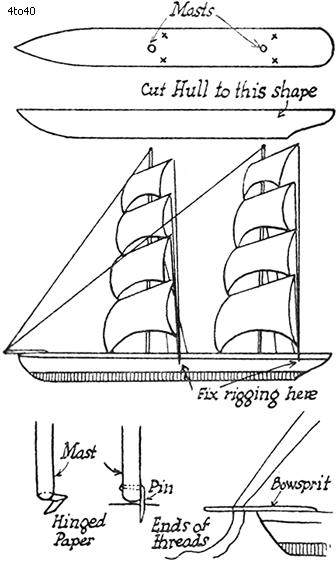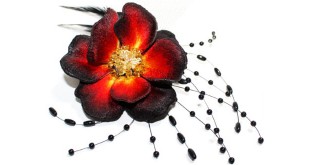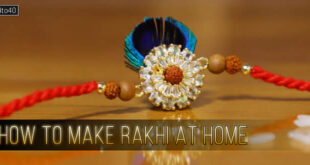 Ship in a Bottle – Everyone is mystified when they see a fully rigged ship sailing in a bottle, with the masts upright and the rigging in position. How does it get into bottle? Obviously the neck of the bottle is much too small for the ship to enter – well, here is a simple solution. The ship is built outside the bottle, with the masts laying down on the deck and attached to the rigging and the ship is pushed through the neck of the bottle. A cotton is kept in the hand and this is pulled and up comes the masts and the ship is miraculously in the bottle, in full sail!
Ship in a Bottle – Everyone is mystified when they see a fully rigged ship sailing in a bottle, with the masts upright and the rigging in position. How does it get into bottle? Obviously the neck of the bottle is much too small for the ship to enter – well, here is a simple solution. The ship is built outside the bottle, with the masts laying down on the deck and attached to the rigging and the ship is pushed through the neck of the bottle. A cotton is kept in the hand and this is pulled and up comes the masts and the ship is miraculously in the bottle, in full sail!
This is how the ship can be built. This hull must be of the size to go through the neck of the bottle, so first of all get a suitable bottle to clear glass and without distortions of any kind. The neck of the bottle should be at least ¾ in. in diameter so that it will take the rigged ship, with lowered masts, quite easily. Almost any shaped bottle will do but a round one, seems to give more effect than other styles. Thoroughly wash the bottle with soap and hot water so that the glass will sparkle and shine, for it is difficult to clean the bottle once it contains your ship.
Now look at the illustration and build the ship on these lines. Use a piece of soft pine for the hull, measuring about 4 in. long, ¾ in. wide and 3/8 in. thick. Draw the outline of the hull in pencil as shown. Neatly cut round the stern (rear) and make the bow (front) pointed, using a sharp penknife for this process. When you have cut away the surplus wood and have shaped the hull as shown, smooth off with sandpaper. The bowsprit is fashioned from a piece of rounded wood, gummed to the deck. Before attaching this, however, pierce two small holes to take cotton, in the position illustrated. To complete the hull, cut out a piece of white writing paper about 1/8 in. wide and gum this all round the top of the hull to represent the deck rail. Hold this in place until quite dry.
The masts and spars can be made from the same kind of wood as the bowsprit. The masts have to be hinged so that they can be lifted from the deck into an upright position. This is quite easily managed by hinging the bottom of each mast with a paper hinge as illustrated in the diagram, or by using a pin bent as shown. The spars are lashed to the mast cross ways and bound the thread, cross winding at the centre. It is an excellent idea to give the masts and spars a coating of varnish to give them a professional appearance.
Cut out the sails from ordinary white notepaper or alternatively, you can use white material that has been starched and ironed. Curl the cut sails round your pencil to give the authentic shape. Make the sails narrower at the top as shown and gum the tops to the fronts of the spars.
The rigging for the model ship is formed from pieces of 8 in. long back thread. Tie each thread to the ends of each spar and let them hang loose. Put a spot of gum at each knot to secure. Now fasten two pieces of thread about one-third from the top of the masts and gum and fasten the ends to the hull, marked with a cross. Now attach two pieces of thread to the top of the two masts, using about 12 in. lengths, and let these hang loose. Now erect both the masts by pulling on the longer threads and attach to the deck by means of pins. To firmly secure the masts, thread the ends of the cotton coming direct from the top of the two masts, through the two holes in the bowsprit and tie so that you can easily undo the knot. Now attach the loose ends of the threads from the spars to tiny pins on the side of the hole as marked on the diagram and cover the knot with a touch of gum to make secure. See that all the sails are of the same angle and quite uniform.
It is advisable to give the hull a coat of white enamel with a red sea line for extra effect. The next step is to make the sea base in which to rest the ship. Prepare this from ordinary putty with a touch of blue oil colour added to give it a realistic sea colour. Well knead the putty and use it without any lumps, rolling into pencil like strips so that you can thread it carefully through the neck of the bottle, trying not to smear the glass. When the putty is in the glass bottle, work on it with a pencil, and try and shape rolling waves so that it looks real. Should you be unfortunate enough to smudge the glass in this process, clean this with alcohol on cotton wool, stuck on the end of your pencil.
To get the model ship ready for inserting into the bottle, loosen the threads at the bowsprit and gently fold back the two masts until they are flat on the deck. Take a look at all the rigging to see that it is secure and now thread the hull through the neck of the bottle and let it rest in position on the putty sea – of course, stern first! You can maneuver the ship into correct position by means of a piece of wire through the neck of the bottle. Raise the near mast by pulling the thread through the hole in the bowsprit until the mast is quite vertical and sails in their correct position. Keep hold of the end of the thread otherwise the mast will collapse. Next pull up the far mast by the same means, pulling the thread taut, and securing by winding round the bowsprit with the help of tweezers, and gumming into position, not letting to until quite dry. Both the threads can be cut off at the bowsprit with small scissors.
It only remains for you to put a cork in the bottle and seal this with colored sealing wax and to make a wooden stand for the bottle so that it can go on show.
 Kids Portal For Parents India Kids Network
Kids Portal For Parents India Kids Network






